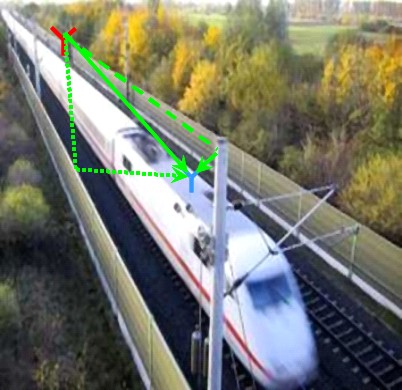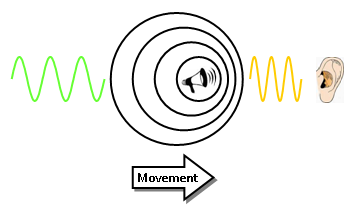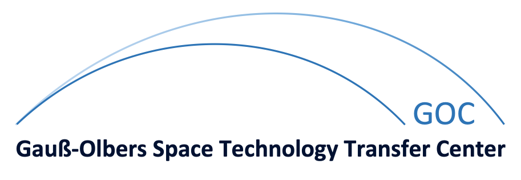High Mobility MIMO-OFDM Transmission With Realistic Propagation Scenarios
|
|
|
Robust and high-rate data transmission in highly mobile environments faces severe problems due to the time-variant channel conditions. Especially, synchronization, channel estimation and data recovery are affected. |
|
This situation is caused by the high Doppler shift and spread of signals between transmitter and a fast moving receiver. In daily life the phenomenon can be observed if an ambulance with switched on siren moves towards or away from an observer. |
|
|
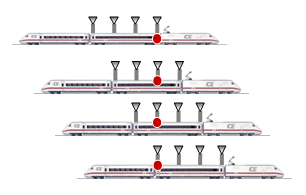 |
|
The focus of this project lies with exploiting multiple transmit antennas in conjunction with distributed receive antennas. This is meant to reduce the loss of time diversity wiith spatial diversit; furthermore, Doppler compensating antenna structure aim at upholding the fundamental principles of MIMO signal processing even under high mobility constraints. |
|
Receiver-side fading reduction is achieved by forming beams into certain direction to divide the Doppler spectrum into several subspectra of reduced Doppler spread.Reducing the Doppler spread leads to less time variant channels such that the subsequent processing steps are simplified. |
|
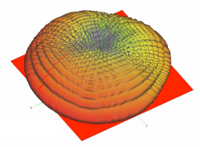 |
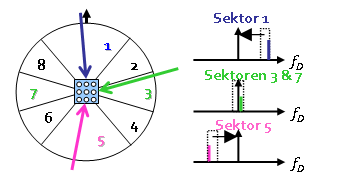
|
|
A further topic is modelling and minimizing antenna coupling as well as optimizing the antenna structures in real world scenarios, in which the different approaches are validated. Such scenarios are a high-speed train and car-to-car communication. |
Details
| Duration: | 06/2008 - 06/2010 |
| Funding: | German Research Foundation |
| Partners: | University Karlsruhe, Institute for Very High Frequency Technology and Electronics |
| Precursor: | Multicarrier systems for fast moving receivers at high data rates |
Publications

-
Temporal Autocorrelation Estimation for OFDM with Application to Spatial Interpolation
BibTEX
P. Klenner, K.-D. Kammeyer
Asilomar Conference on Signals, Systems, and Computers, Monterey, CA, USA, 26. - 28. October 2008 -
Cyclic Delay Diversity for OFDM with Sectorized Antenna Reception
BibTEX
P. Klenner, K.-D. Kammeyer
13th International OFDM-Workshop 2008 (InOWo 08), Hamburg, Germany, 27. - 28. August 2008 -
Doppler compensation for OFDM transmission by sectorised antenna reception
BibTEX
P. Klenner, K.-D. Kammeyer
European Transactions on Telecommunications, Vol. 19, No. 5, pp. 571-579, August 2008 -
Space-Time Coded OFDM Transmission with Spatial Interpolation in the Presence of Severe Doppler Spread
BibTEX
P. Klenner, K.-D. Kammeyer
3rd International Symposium on Communications, Control and Signal Processing (ISCCSP 08), St. Julians, Malta, 12. - 14. March 2008 -
Performance of Space-Time-Coded OFDM with Sectorized Antenna Reception
BibTEX


P. Klenner, K.-D. Kammeyer
International ITG/IEEE Workshop on Smart Antennas (WSA 08), Darmstatdt, Germany, 26. - 27. February 2008 -
Frame-Synchronization for OFDM-Transmission with Sectorized Antenna Reception over Rapidly Fading Channels
BibTEX

P. Klenner, K.-D. Kammeyer
IEEE 4th International Symposium on Wireless Communication Systems 2007 (ISWCS 07) , Trondheim, Norway, 17. - 19. October 2007 -
Time- and Frequency Synchronization for Spatially Interpolated OFDM
BibTEX


P. Klenner, K.-D. Kammeyer
12th International OFDM-Workshop 2007 (InOWo 07), Hamburg, Germany, 28. - 29. August 2007 -
Doppler-Compensation for OFDM-Transmission by Sectorized Antenna Reception
BibTEX


P. Klenner, K.-D. Kammeyer
6th International Workshop on Multi-Carrier Spread Spectrum (MCSS 07), Herrsching, Germany, 7. - 9. May 2007 -
Spatially Interpolated OFDM with Channel Estimation for Fast Fading Channels
BibTEX


P. Klenner, K.-D. Kammeyer
IEEE Vehicular Technology Conference 2007 (VTC2007-Spring), Dublin, Ireland, 22. - 25. April 2007 -
A Doppler-Compensated Noncoherent OFDM-Transceiver with Sectorized Antenna Reception
BibTEX


P. Klenner, S. Vogeler, K.-D. Kammeyer
International ITG/IEEE Workshop on Smart Antennas (WSA 07), Vienna, Austria, 26. - 27. February 2007



